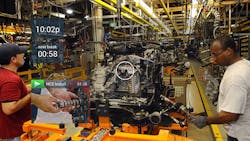Upskilling the Industrial Workforce is in Our Sight
Heavy industry in the 21st century is undergoing a profound transformation, with new technologies bringing data and smart, connected equipment to the production environment. Despite increasing automation, people remain an essential component of industrial productivity. However, the manufacturing, logistics and on-site jobs of tomorrow are no longer the low-skill tasks they were in the past. The workforce for the next industrial revolution needs to work side-b y-side with machines, constantly connected to the data, processes and people they need to deliver maximum productivity.
The critical question facing the industry is how to upskill today’s workers to make them ready for the new world of hands-on work. Many of the most knowledgeable and experienced workers are approaching retirement, or are at an age where retraining through standard methods is burdensome and unrealistic. Promising young talent, meanwhile, views manufacturing through the lens of the previous generation’s experience with downsizing and uncertainty, and potential contributors are guided by parents and educators to seek work in other sectors of the economy.
The result is a crisis that economists say will leave millions of American manufacturing jobs unfilled in the coming decade, and hurt the competitiveness of companies in the global marketplace. So how can heavy industry reverse these dynamics, provide people with the advanced skills they need to be valuable contributors, complement their investments in data and equipment, and rejuvenate the image of industrial work for the next-generation workforce?
Upskill the workforce, upskill the business. At our company, we’ve been grappling with these issues since 2010, when we first set out to use wearable technology to give hands-on workers access to information and connectivity that fit their unique workplace scenarios. We set out to create a platform, Skylight , to enable our customers to mobilize documents, real-time data, collaboration and workflows from their existing enterprise systems directly to front-line workers, using smart glasses that do not require them to take their hands off their equipment or break from their task to consult a manual or computer terminal.
In six years, we’ve seen smart glasses technology move out of “innovation pilots” and into full production. We’ve also observed industrial giants achieve remarkable results: productivity improvements of 46% or more, error reduction rates of 30%, and capacity utilization increases of 20%. Those metrics validate the belief that if you give people better tools, they can elevate not only their own performance, but the performance of the entire business.
Closing the skills gap by closing the investment gap. For decades, businesses in other industries have been investing in better information technology, first for their desk workers and then for remote and mobile workers, and have seen enormous benefits in speed, agility and innovation as a result. Until now, the industrial workforce has been left behind by these advances because it is difficult to deploy information technology in environments where people work with their hands, and where the culture of the workplace is not conducive to collaboration or data.
Smart glasses enable these workers to fully participate in the connected workplace in the flow of their ordinary routine. People can access the most current documents, including product information, technical specifications and instructions, using a simple gesture or voice command. They can connect to experts and colleagues in remote locations and let them see through their eyes to resolve problems quickly. Workers can check down critical safety and quality assurance processes digitally as they work, reducing risk and errors while providing documented accountability for regulatory compliance at every step of the process. Senior workers can capture their “tribal knowledge” of informal practices by recording and narrating as they work; younger and less experienced staff can access those recordings whenever and wherever they want, as they work.
Best of all, these new capabilities replace outdated paper-based processes and classroom training that most workers find tedious and burdensome anyway. Research shows that providing information through heads-up displays as people are engaged in the task they are learning enables nearly instantaneous improvement and reduces the cognitive load imposed by trying to alter established habits. We’ve seen that workers, even those skeptical of new technologies, embrace the solution enthusiastically, while employers immediately see the advantages of having workers learn and adapt on the job, without being taken off the line to learn new skills and processes.
Rejuvenating the Industrial Workforce. This kind of people-centered technology not only supports the business goals of cost savings, quality improvement and competitiveness in tandem with other investments in data, equipment, Internet of Things and robotics. It also demonstrates that industrial work has a real future in the 21st century.
When companies are willing to invest in people, people are willing to invest their talents and careers in those companies. When young people see not just income potential but also the prospect of working with cutting-edge technology and doing meaningful work, the rusty tarnish surrounding their perceptions of industrial work fade — replaced by a brighter vision of people and machines working together as partners in creating value.
Brian Ballard is the CEO & co-founder of Upskill (formerly APX Labs), where he is working on the next industrial revolution — using smart glasses to create powerful ways for the workforce to interact with the digital and physical world. Prior to founding Upskill, he served as vice president of product development at BTS, as CTO of Mav6, and spent more than a decade with the NSA, where his work ranged from FPGA-based supercomputing to software intelligence fusion for counter terrorism. He has contributed to a book, multiple publications, and patents related to wearable computing. Brian holds a masters and bachelors in Electrical and Computer Engineering from Carnegie Mellon and an MBA from University of Maryland. You can read more from him here.
